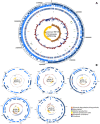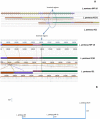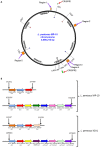In silico genomic insights into aspects of food safety and defense mechanisms of a potentially probiotic Lactobacillus pentosus MP-10 isolated from brines of naturally fermented Aloreña green table olives
- PMID: 28651019
- PMCID: PMC5484467
- DOI: 10.1371/journal.pone.0176801
In silico genomic insights into aspects of food safety and defense mechanisms of a potentially probiotic Lactobacillus pentosus MP-10 isolated from brines of naturally fermented Aloreña green table olives
Abstract
Lactobacillus pentosus MP-10, isolated from brines of naturally fermented Aloreña green table olives, exhibited high probiotic potential. The genome sequence of L. pentosus MP-10 is currently considered the largest genome among lactobacilli, highlighting the microorganism's ecological flexibility and adaptability. Here, we analyzed the complete genome sequence for the presence of acquired antibiotic resistance and virulence determinants to understand their defense mechanisms and explore its putative safety in food. The annotated genome sequence revealed evidence of diverse mobile genetic elements, such as prophages, transposases and transposons involved in their adaptation to brine-associated niches. In-silico analysis of L. pentosus MP-10 genome sequence identified a CRISPR (clustered regularly interspaced short palindromic repeats)/cas (CRISPR-associated protein genes) as an immune system against foreign genetic elements, which consisted of six arrays (4-12 repeats) and eleven predicted cas genes [CRISPR1 and CRISPR2 consisted of 3 (Type II-C) and 8 (Type I) genes] with high similarity to L. pentosus KCA1. Bioinformatic analyses revealed L. pentosus MP-10 to be absent of acquired antibiotic resistance genes, and most resistance genes were related to efflux mechanisms; no virulence determinants were found in the genome. This suggests that L. pentosus MP-10 could be considered safe and with high-adaptation potential, which could facilitate its application as a starter culture and probiotic in food preparations.
Conflict of interest statement
Figures






References
-
- Wacher C, Díaz-Ruiz G, Tamang JP. Fermented Vegetable Products In: Tamang JP, Kailasapathy K, editors. Fermented foods and beverages of the world. Boca Raton, USA: CRC Press; 2010. pp. 149–190.
-
- Venema K, Meijerink M. Lactobacilli as probiotics: discovering new functional aspects and target sites In: Venema K, do Carmo AP, editors. Probiotics and Prebiotics: Current Research and Future Trends. UK: Caister Academic Press; 2015. pp. 29–42.
-
- Food and Agricultural Organization of the United Nations and World Health Organization, editor. Report of a Joint FAO/WHO working group report on drafting guidelines for the evaluation of probiotics in food; 2002. April 30, May 1; Ontario, Canada.
-
- Granato D, Branco GF, Nazzaro F, Cruz AG, Faria JAF. Functional foods and non dairy probiotic food development: trends, concepts, and products. Compr Rev Food Sci Food Saf. 2010; 9: 292–302. - PubMed
-
- Peres CM, Hernandez-Mendoza A, Peres C, Malcata FX. Review on fermented plant materials as carriers and sources of potentially probiotic lactic acid bacteria with an emphasis on table olives. Trends Food Sci Technol. 2012; 26(1): 31–42.
MeSH terms
Substances
LinkOut - more resources
Full Text Sources
Other Literature Sources
Medical

